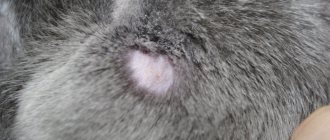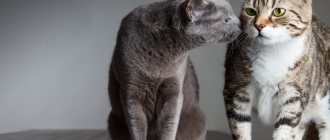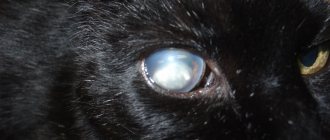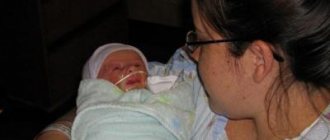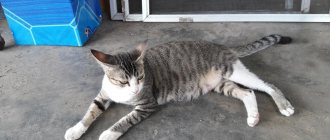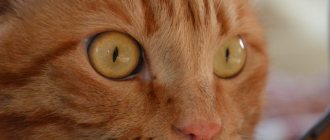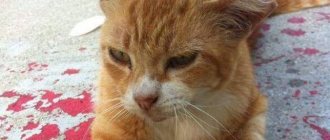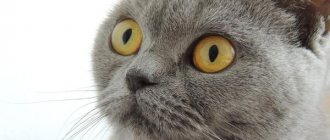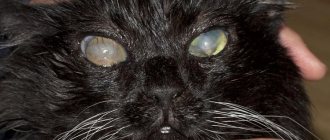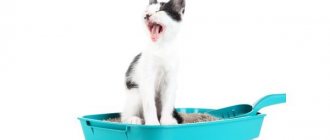Tripelphosphates in cat urine are stones that can form in the bladder, pelvis or renal parenchyma. Most often, this disease is simply called ICD, that is, urolithiasis.
If there are problems with metabolism, large quantities of poorly soluble salts and crystals enter the urine. They lead to the formation of small stones that block the urethra, causing inflammation and pain.
Causes of ICD
Unfortunately, there are a lot of reasons for the development of ICD, and because of this it is more difficult to find out the cause. However, as a rule, the most common are:
- improper diet for your pet - lack of carbohydrates with high protein intake, too much fish in food;
- the norm for obtaining vitamins A and D is not met;
- pet's sedentary lifestyle;
- obesity;
- early castration of the male;
- breed predisposition to diseases;
- the animal does not drink fresh water;
- development of urinary tract infection;
These above factors greatly affect the metabolism - it is disrupted and an excess amount of metabolic products is produced in the urine. As for breed predispositions, breeds such as Persians very often suffer from urolithiasis - nothing can be done about it.
Neutered cats are also at high risk, especially those who were neutered too early. In castrated cats, there is a hormonal imbalance, the urethra may narrow and struvite will form very quickly. Statistics say that 7% of cats that come to the veterinary clinic are diagnosed with urolithiasis.
It is often said that stones can form because the cat is given the wrong diet. Excessive feeding of expensive dry food sometimes leads to KSD. When you hear such statements, do not listen to them. These foods are perfectly balanced and will not cause such disturbances. Research also shows that cats who eat conventional food are more likely to develop stones than those who eat dry food. The most important thing that should be included in the mandatory diet is clean water. It must be in sufficient quantities.
Uroliths, calcium oxalates and struvite-type formations in the urine of male cats are not the norm and indicate various pathological processes in the body. Veterinarians say that urolitic disorder occurs in pets under the age of 6 years, especially if they are fed only dry food. There are other reasons due to which oxalates in the urine or struvite formed by magnesium salts or ammonium phosphates may be detected:
- Disturbed nutrition. With excessive intake of animal protein into the body, the intestinal microflora is disrupted, resulting in the formation of toxins that change the composition of urine.
- Deviations in water-salt balance. The lack of fluid in cats or its poor quality leads to the fact that the body becomes dehydrated and the concentration of salts increases, and chemical components precipitate.
- Congenital disorders. Struvite urolithiasis is more often recorded in pets that do not belong to any breed.
- Disturbed hormone levels. Increased production of parathyroid hormone leads to increased calcium content and acidity of urine, which causes crystallization.
- Insufficiently active way of life. Struvite and oxalates in urine are more often detected in cats that move little, sleep a lot and are not very playful. Such pets have a high risk of developing diabetes mellitus, excess weight problems, and progression of pancreatic inflammation.
Types of urinary formations and risk factors for their development
There are two types of stones diagnosed in cats:
- Struvite or tripelphosphates are salts of trivalent phosphorus. This type of urolith accounts for up to 80% of all stones formed. Most often, struvite urolithiasis is observed in cats. Solid crystals or loose amorphous compounds form in urine with a pH> 7 when there is an excess of phosphorus and magnesium in the diet. Adult cats from 1 to 6 years old become ill.
- Oxalates - salts of oxalic acid are formed in neutral or acidic urine when there is an excess of calcium in the diet. Older pets over 8 years of age are affected.
The occurrence of a mixed type of urolithiasis cannot be excluded. When both struvite and oxalates are present.
The following reasons for the development of ICD are identified:
- lack of drinking water: the concentration of salts increases; their excess precipitates;
- hard water containing a large amount of magnesium promotes the formation of struvite-type compounds;
- abuse of fish during natural feeding leads to excess phosphorus, which is not completely excreted in the urine and forms tripelphosphates;
- Abuse of calcium-rich dairy foods - kefir or cottage cheese - leads to excess calcium and the formation of oxalates.
In cats, urolithiasis occurs more often than in cats due to the anatomical features of the body. The long, winding urinary duct has more nooks and crannies in which a grain of sand can get stuck. A congestion forms, urine stagnates and microflora multiplies.
Be sure to read:
Kidney failure in cats: causes, symptoms for acute and chronic forms, treatment
A dead bacterial cell or a piece of desquamated epithelium becomes a center of crystallization, on which layers grow, and a large stone is formed that can completely block the outflow of urine. Conditions are created for the formation of kidney stones and the development of nephrolithiasis.
The predisposition of castrates to urolithiasis is explained by the fact that sterilization is carried out at the age of 6-9 months, when growth is not yet complete.
Live weight continues to increase, but the diameter of the ureter remains the same. If the operation had been performed at 12 months, there would have been no problems with the size of the urinary duct. But castration carried out after puberty has its drawbacks: the cat will mark the corners for some time, and the cat will meow invitingly.
An unbalanced diet, not only natural, but also ready-made economy-class food, predisposes to the formation of urinary stones.
Incomplete proteins are not fully absorbed; excess amino acids are converted into uric acid. which is poorly soluble on its own and reduces the solubility of other uric salts. This is why neutered cats need to be put on a diet for sterilized cats.
How to properly treat tripelphosphates and struvite in cat urine
There are salts in the urine of any cat - this is absolutely normal. But if their number increases, the concentration of urine increases, and salts precipitate over time. As a result, struvite is formed - a serious pathological condition in which medical attention cannot be avoided. Today, urolithiasis is diagnosed even in young cats. There are many reasons for this. Among the main provoking factors are:
- Improper nutrition - with an unbalanced menu, the animal receives little or, conversely, a lot of proteins and proteins, which is why the composition of urine is disrupted. The salts from it form a sediment, and then stones. In such a situation, the development of urolithiasis is inevitable. Similar consequences occur if the cat is regularly given dry food. The main reason is prolonged dehydration of the body.
- Long-term use of anti-inflammatory drugs - with this type of therapy, the veterinarian usually prescribes maintenance therapy. Without it, stones form and struvite appears in the urine.
- Long-term retention of urine, which has become a habit. Those. if for some reason the animal is accustomed to endure a long time to go to the litter box. Because of this, the concentration of urine increases, the salts present in its composition form a sediment. If this happens regularly, struvite occurs.
- Oncological diseases - they disrupt all processes in the cat’s body and change the composition of urine. A lot of salts accumulate in it, which is why stones form. Struvites are usually small and easily removed along with urine.
- The occurrence of an inflammatory process in the renal system as a result of infection. It provokes swelling of internal organs and urinary retention, which leads to the formation of stones.
- Increased production of caukin - if there is a lot of this protein, then its excess does not have time to be excreted from the body, which leads to the formation of an insoluble sediment in the urine. The disease develops rapidly under any living conditions and nutrition. First, the cat suffers from constant cystitis, and then struvite appears in the genitourinary system. Lifelong therapy is required.
- Hormonal imbalances often lead to the accumulation of salts. The animal’s general well-being deteriorates greatly, so therapy must be comprehensive.
Struvite formation is a serious pathological condition that requires medical attention.
Regardless of the reasons for the formation of struvite, the cat should be provided with high-quality treatment aimed at cleansing the urinary organs and eliminating the root cause of the disease.
Unexplained cystitis. This is the most common cause of the formation of crystals in the urine of cats. This cause accounts for 50-65% of cases. In other words, cystitis is irritation of the bladder. Although the reason for this is unknown.
2. Uroliths. These are urinary stones. Calcium oxalate and struvite stones in cat urine are the most common types of urinary stones. Uroliths are found in 15-20% of cats suffering from crystal formation in the urine. You can fight struvite stones with a special diet that causes the stones to dissolve. There is no similar treatment for getting rid of calcium oxalate stones. The type of stones is determined by ultrasound.
3. Obstruction of the urethra. Urethral obstruction is usually caused by plugs, which are formed from the accumulation of large amounts of protein mixed with minerals. Some of these plugs are formed from pieces of tissue, round particles and blood cells. Other causes of crystals in the urine include: stress, poor diet (mostly dry food), cancer, trauma and anatomical defects of the urethra, and bacterial infections.
1. Pain relief. Prescribing painkillers is necessary when crystals are detected in the urine, since the cat is in an extremely painful condition.
2. Increase your water intake. Water will help dilute your urine and prevent future crystal formation. Water promotes the production of more urine, thereby helping to flush out crystals from the urinary tract. Try to get your cat to drink as much water as possible.
3. Reduce Stress: Your cat may become stressed due to changes in diet, getting a new cat, or having to share food and litter box with another cat. Whenever possible, allow your cat to have his own space and personal belongings to avoid stress that eventually leads to the formation of crystals in his urine.
4. Prescribing antispasmodic drugs. These drugs will help relax the bladder and urethra. Relaxing the walls of the urethra promotes better urination and makes this process less painful. Amitriptyline can be added here. It is a sedative that reduces anxiety in overly excitable cats.
CONSULT YOUR VETERINARIAN
The presence of tripelphosphate in a cat's urine indicates development. Normally, the urine of a healthy animal contains about 5% dissolved organic and inorganic salts.
If their concentration increases, the salts begin to crystallize and form solid (stone) compounds of a fairly large size. Deposits of formations occur in the urinary system of animals.
We suggest you read: Preventive rabies vaccination for pets. Rabies vaccines for cats and dogs.
Symptoms
The disease usually develops slowly and there are no visible symptoms for a long time. However, problems can be noticed with a urine test. Urine pH shifts toward the acidic side for oxalates, phosphates, and urates. This increases the density of urine. Visible symptoms include:
- the cat gradually begins to lose its appetite, and over time it completely refuses to eat;
- her condition can be described as depressed, she is not at all inclined to play or communicate with her owner;
- The cat often licks the perineum.
If there is a blockage in the urinary tract, you may experience painful colic when urinating. The animal is extremely restless and meows while urinating. Sometimes body temperature rises and breathing quickens. The amount of urine usually decreases significantly. The urine may be bloody or cloudy. In some cases, urination is completely absent. Over time, the cat becomes apathetic and begins to vomit severely. In this condition, the kidneys stop producing urine and the cat will die if treatment is not started immediately.
How not to miss symptoms of deviation?
A sign of developing urolithiasis is considered to be frequent urination in small portions of urine.
Urolithiasis, in which struvite is detected in the urine of a pet, may not cause concern in the owners for a long time, since there are no obvious signs of a disorder. Oxalate, urate and struvite stones appear as their size increases. Pathology in cats can be recognized by the following symptoms:
- frequent urge due to slight need;
- uncontrolled process of urine excretion;
- strong strain when emptying the bladder;
- urine comes out in a thin stream or just drips a little;
- bloody impurities;
- cloudy urine color;
- constant desire to drink.
Symptoms of the disease
If your pet has problems with the urinary system, it is important to recognize the problem in time and take all necessary measures to solve it. You can suspect something is wrong based on symptoms such as:
- Frequent urination, with little urine coming out. The cat feels discomfort and often meows in pain.
- Spontaneous release of urine - this usually occurs when the position changes. The volume of fluid that flows out may vary and sometimes contains struvite.
- Pink urine - appears due to the fact that stones, when moving, damage the ureter or urethra.
- Turbidity of urine - the culprit is not only struvite, but also sand suspension. At the same time, a characteristic odor of physiological fluid appears.
- Increased thirst – due to kidney problems, the cat is constantly thirsty.
- Lack of appetite, restless behavior.
Increased thirst is one of the causes of kidney dysfunction in cats
A specialist will examine the animal on an outpatient basis, conduct the necessary tests and tests, and then make an appropriate diagnosis.
How does the disease manifest itself?
The disease develops over a long period, but begins acutely and is accompanied by the following symptoms:
- Cloudy urine.
- The appearance of sediment or blood.
- Swelling in the urethral area due to frequent licking.
- Difficulty urinating, the animal sits on a tray for a long time or sits on any part of the room.
- Discharge of a small amount of urine (about 5 ml).
- Changing posture while going to the toilet: head slightly lowered;
- arched back;
- the front legs are straightened;
- pelvic muscle tension;
- the hind legs are in a vertical position;
- painful meowing during urination.
Diagnostics
Based on the history collected from the breeder and examination of the animal, the veterinarian prescribes:
- Analysis of urine. This is the main method for detecting struvite and tripel phosphates. This examination includes research:
- physical properties (color, transparency, density, ph);
- chemical composition (presence and amount of protein, glucose, acetone bodies, hemoglobin, bilirubin);
- sediment under a microscope (presence of salts and microorganisms).
- Ultrasound. The method allows you to detect formed salt crystals.
Based on the diagnostic results, the veterinarian prescribes treatment.
The urine of a sick pet must be examined by microscopy.
- urine microscopy;
- determination of protein amount;
- urine concentration test.
What is a urine test and how is it performed?
Laboratory urine testing is prescribed to an animal for any pathology, for preventive purposes and to monitor the effectiveness of the prescribed treatment. So what is a urine test, why and how is it performed?
Metabolic products and various chemical compounds are excreted from the animal's body in urine. The laboratory assistant determines their presence and quantity in the submitted sample of biological fluid. In addition, the physical characteristics of urine, such as odor, color, clarity and density, are assessed, and microscopic examination of the sediment is carried out to identify red blood cells, white blood cells, casts, epithelial cells, crystals and amorphous masses of salts.
As a result of a comprehensive laboratory analysis, the veterinarian can judge the general health of the four-legged patient and various pathologies. Particular importance is given to urine analysis in the diagnosis of metabolic disorders, blood diseases, pathologies of the genitourinary and endocrine systems.
Urolithiasis (UCD) in cats. Feeding, prevention, treatment.
As a separate pathology, it does not pose any risks to the cat’s health, but it can cause extremely serious complications. Passing through the urinary tract, stones injure soft tissues, cause pain, and also interfere with the natural movement of urine. In advanced cases, this can lead to kidney failure.
Cylinduria is also observed with pyelonephritis, fever, and dehydration.
Urolithiasis – urolithiasis – is the most common and dangerous disease in cats. The high mortality rate of animals confirms this. It is characterized by the presence of sand and stones in the organs of the genitourinary system - kidneys, bladder.
According to statistics, cats most often suffer from urolithiasis at the age of 5.
The risk group includes:
- males;
- age category 2 – 6 years;
- obese animals;
- long-haired breeds;
- males after sterilization;
Urolithiasis is considered to be a disease of cats. In females, the width of the urethra is greater, so the risk of pathology is reduced.
Urolithiasis.
The disease has genetic roots and is chronic, with acute relapses.
The latent course can last up to 2 years, after which an exacerbation occurs and it is difficult to do without surgery.
This ultrasound shows urolithiasis in a cat. Although cats are much less likely to suffer from this disease than cats.
The fact that sand and stones appear in the pelvic organs depends on several components. These components, in turn, are divided into external and internal.
External factors
Water quality plays a direct role in the development of urolithiasis in cats.
The list of external factors includes:
- climatic conditions - depending on how hot it is in the house, urine becomes highly concentrated and it becomes impossible to filter it through the kidneys;
- the quality of the liquid consumed - the presence of salts in the water leads to the accumulation of salts in the urine and, as a result, the formation of stones;
- nutrition - an excess or lack of proteins in food leads to an accelerated concentration of urine;
- hypovitaminosis, vitamin deficiency - a lack of vitamins provokes a lack of nutrition of the epithelium, accelerating its destruction.
Internal factors
Predisposition to urolithiasis can be transmitted genetically.
Factors acting from within the body are called internal or endogenous. These include:
- hormonal disorders;
- anatomical feature;
- gastrointestinal disorder;
- heredity;
- infections, viruses.
The resulting stones are of two types: struvite and oxalate.
Struvites were removed after surgery to treat urolithiasis.
The most common cause of urolithiasis is metabolic disorders.
Minerals entering the cat's body react with toxins. Dying bladder cells become foci for the appearance of crystals. Passing through the urinary canals, the crystals injure their mucous membrane.
An excessive amount of such crystals is the cause of blockage of the lumen, preventing the release of urine.
The kidneys continue to produce urine, but it accumulates in the lumen, which causes poisoning of the entire body, leading to severe intoxication.
The peak of the disease occurs in autumn and spring. The presence of inflammatory processes in the kidneys, liver, and gastrointestinal tract plays a significant role in the occurrence of pathology. The consequence of these processes may be the formation of crystals. Individual predisposition is also a significant factor in the development of the disease.
Features of the anatomy - the lumen of the urethra is too narrow, which makes it difficult to remove fluid, forming a “congestion”.
Symptoms of urolithiasis.
The presence of stones or sand is diagnosed in the laboratory, but at home a preliminary diagnosis can be made based on some signs.
- The cat urinates frequently, sometimes uncontrollably, sometimes with difficulty and in small portions.
- During urination he behaves restlessly.
- The urine becomes darker, has a reddish tint, or contains blood.
- The animal tries to move less and refuses food and water.
- Due to the small waste of urine, the stomach becomes larger.
- The body becomes intoxicated and vomiting begins.
- The temperature rises to 39–40 degrees. It is aggravated by convulsions and trembling of the whole body.
Such symptoms indicate a long-term illness, at least 1–2 years.
It is important to prevent a severe form and constantly undergo veterinary examination, otherwise the fatal outcome is 80%.
With timely diagnosis and treatment, the prognosis is favorable. A veterinarian draws up a complete clinical picture based on a visual examination and laboratory tests.
Therapy for urolithiasis is carried out comprehensively, using radical methods in the form of surgical removal of stones and cleansing of sand from the genitourinary tract.
Insertion of a catheter through the ducts into the bladder under general anesthesia.
The treatment period is complex and lengthy and requires considerable effort on the part of the attending physician and the cat’s owner. The first emergency aid is to allow urine to pass freely. A catheter is inserted through the ducts into the bladder under general anesthesia. Difficulty in inserting a catheter is an indication for immediate surgery, during which a catheter is inserted and left in place for 1–2 weeks.
Intensive treatment involves the use of symptomatic therapy: painkillers, antispasmodics. Anti-inflammatory, antibiotics, immunostimulants, diet.
Along with the use of narrowly targeted drugs, medications that support the functioning of the cardiovascular system and gastrointestinal tract are indicated.
Use a drip to compensate for the lack of fluid and blood.
PHYTOAELITA® HEALTHY KIDNEYS (PHYTOAELITA® SANUS RENES). Consultation with a doctor is required.
Drugs often used in the treatment of KSD with the possibility of urine patency: nitroxoline tablets, “Healthy Kidneys” phytoelite, phytolysin solution, neurovital tablets, baralgin injections.
To clean and prevent infection, a solution of Metragil with saline is injected into the catheter. During the rehabilitation period, restorative therapy is required. Use Cotervin, Nephrocat, Renal powder, Stop-cystitis suspension or tablets, Urinari tract support tablets.
The prescription of a diet for urolithiasis depends on the type of stones located in the animal’s genitourinary system.
The presence of oxalates prevents the entry of oxalic acid into the body. It is found in liver, kidneys, and tea. Food containing calcium is subject to restriction: dairy, fermented milk products.
We suggest you read: Gangrenous stomatitis in cats: symptoms and treatment
Veterinary hospitals sell special food for cats that suffer from urolithiasis.
It is recommended to saturate the body with alkali, which is found in beets, legumes, and cauliflower. Products rich in magnesium are shown: peas, boiled meat, fish, rice, and other types of cereals. Avoid completely dry food and use canned meat and fish.
Struvite damage implies the exclusion of foods rich in calcium and its compounds. This group includes: dairy and fermented milk products, egg yolk.
Recommended: boiled beef, egg white. You can include in your diet: boiled young veal, rice, carrots.
Special food for cats and kittens with urolithiasis.
You can dilute it with: oatmeal, liver, cabbage. Use canned meat and fish food. Dry food is only medicinal, with useful additives for the cat. The diet should be agreed with the doctor and strictly adhere to the feeding regimen and norms.
Throughout rehabilitation, periodically carry out laboratory urine tests and strictly monitor the animal’s well-being. Combining ready-made dry or canned food in the same container with homemade food is strictly prohibited.
A set of preventive measures for urolithiasis in cats is available to everyone. It is necessary to control the quality of your pet’s food and its quantity. Overeating can lead to increased alkalinity in the urine. Insufficient intake of calcium in the body contributes to the formation of phosphate formations, so moderate consumption of foods rich in calcium compounds is important.
Monitor your cat's drinking habits. The water must be purchased, soft or boiled and settled. Do not use dry food as the main food - only as complementary food; if possible, it should be completely excluded from the diet.
Complementary feeding with dry food should be provided with sufficient water. Feed the animal not only solid food. Add soups and liquid cereals to your diet. pet in favorable sanitary and hygienic conditions, to prevent the occurrence of other infections.
To avoid the occurrence of urolithiasis or its recurrence, mandatory medical examination is indicated. Being in a safe environment, the animal has a minimum risk of developing pathologies of the genitourinary system.
We specially selected this picture. Quarantine after surgery must be strictly observed!
The first few weeks after surgery require strict quarantine of the animal. A balanced diet, a ban on leaving the house and contact with other animals. Do not allow “accidental” food or eating outside the regime. Do not skip mandatory medications indicated for rehabilitation.
Diet and feeding rules for cats with ICD
After removal of stones by conservative or surgical means, the animal must be on a special diet for the rest of its life to prevent the formation of stones in the organs of the urinary system.
Rules for feeding a cat with ICD
- The best option is to use ready-made wet food designed for feeding animals with urolithiasis.
- A prerequisite is to ensure that the cat has constant access to a bowl of fresh filtered water, which should be changed at least 2 times a day.
- It is unacceptable to mix ready-made food with natural products.
- When choosing a traditional diet, it is necessary to reduce the content of eggs, dairy products, offal, eliminate smoked, fried, fatty and spicy foods. The cat can be fed boiled beef, lamb, veal, chicken, white fish with the addition of rice, buckwheat or oatmeal, carrots, beets and cauliflower.
How to stabilize your pet's condition?
Treatment with drugs
If struvite is detected sporadically, then the disease can be treated with medications prescribed by a veterinarian. Medicinal dissolution includes various types of drugs that help ensure the necessary balance of water and salts and help eliminate unpleasant symptoms in cats. For struvite in the urine, the medications listed in the table are prescribed.
| Antibiotics | "Amoxisan" |
| "Oxacillin" | |
| "Amoxiclav" | |
| "Bicillin" | |
| "Ampicillin" | |
| Medicines to relieve spasms and pain | "No-Shpa" |
| "Papaverine" | |
| "Drotaverine" | |
| "Platifillin" | |
| Antifungal | "Griseofulvin" |
| Drugs that destroy stones | "Kotervin" |
| "Stop Cystitis" | |
| Anti-inflammatory | "Rimadyl" |
| "Ketofen" | |
| "Trokoksil" | |
| "Urolit" |
Preventive recommendations
It is possible to prevent the appearance of struvite in the urine of cats if you follow some prevention rules. To prevent urolithiasis, it is recommended to monitor your pet’s diet; it must be balanced and contain the necessary microelements. It is recommended that pets be given high-quality drinking water from bottles or filtered.
It is possible to prevent struvite in urine by frequently monitoring the acidity level using special tests. It is important to regularly change the lining of the litter box and clean the cat's litter box. To prevent obesity, which is one of the common factors in the development of pathology, you should give your cat high-quality food and active games. The source of struvite can be hypothermia or overheating of the pet’s body, so it is better to avoid such situations.
Prevention
To prevent tripel phosphates from appearing in the cat’s urine, the owner should provide the pet with the correct drinking regime. It is necessary to limit the consumption of fish and dairy products. Veterinarians recommend high-quality balanced food, which not only saturates the animal’s body with useful substances, but is also a preventive measure for urolithiasis. And also the owner must monitor the cleanliness of the tray, since the cat will not go to a dirty place and will tolerate it. You should play with your pet so that it moves more.
Classification
– Oxalates and phosphates. This is the most common category of education. Stones are diagnosed in 70% of patients diagnosed with urolithiasis. The basis of formations of inorganic origin are calcium salts.
– Struvite and phosphate-ammonium-magnesium stones. This type of stones occurs in 20% of patients. The cause of the formations is diseases of the urinary tract of an infectious nature. That is why they are called infectious.
- Urats. Diagnosed in 10% of all patients. The cause of the appearance is excess uric acid and some pathologies of the digestive tract.
– Xanthine and cystine stones. Quite rare formations. Occurs in 5% of patients. Experts associate their appearance with congenital pathologies and genetic disorders.
It is quite difficult to detect stones that are pure in composition; half of the patients are diagnosed with mixed type formations.
Prevention measures and features of keeping an animal with urolithiasis
KSD is a chronic disease that causes a lot of suffering to pets and their owners, but if preventive measures, feeding and maintenance conditions are observed, even with a diagnosis of urolithiasis, a pet can live a long, carefree life.
Features of keeping an animal with ICD:
- The cat must have constant access to fresh water.
- It is recommended to clean the tray in a timely manner to avoid urinary retention in your pet.
- The owner needs to control the weight of the furry pet.
- It is unacceptable to overfeed the animal or treat it to prohibited foods.
- It is recommended to encourage the animal to play actively to eliminate the risk of developing stagnant processes.
- It is worth treating chronic and infectious diseases in a timely manner, avoiding drafts and hypothermia.
- An animal diagnosed with ICD must be brought annually for a preventive examination to a veterinary clinic with mandatory laboratory testing of urine and blood tests.
Cystine stones
There are quite a lot of classification criteria.
- By quantity: half of the patients are diagnosed with single stones; often one has to deal with the formation of two or three stones in the kidneys; the least rare case is multiple formations in the kidneys.
- By location in the body: unilateral and bilateral.
- Shape: round, flat, with edges, spikes, coral-shaped.
- By size: the size of the formation can vary from the eye of a needle to the size of the entire kidney cavity.
- According to the location: stones form in the kidney, bladder or ureter.
Types of Kidney Crystals
The most common classification of solid formations by chemical composition. If earlier doctors assumed that the formation of stones was associated with the quality of water that the patient drinks, the climate and geographical features of the area where he lives, today there are many supporters of a different hypothesis among specialists. It is generally accepted that the process of urolithiasis begins in the body when the ratio of salts and colloids in urine is disrupted.
The classification of stones by chemical composition is as follows:
- oxalates – formed from salts of oxalic acid;
- phosphates – formed from calcium phosphate;
- urates – the main component is uric acid salts;
- carbonates – formed from calcium salts of carbonic acid;
- struvite - formed from ammonium phosphate.
Classification of stones by chemical composition
In addition, it is necessary to isolate stones of organic origin. These include:
- cystine and xanthine;
- cholesterol;
- protein.
Did you know that open operations to remove stones are being replaced by more gentle surgical methods of treatment? , surgical and conservative treatment, as well as the causes of stone formation.
You will find recipes for herbal remedies for various kidney diseases.
A rather rare type of stones, the formation of which is caused by a genetic pathology - cystinuria.
Children and young people are most susceptible to the development of cystine stones.
The main component of the stone is amino acid.
Doctors call the main feature of the symptoms of the disease constant pain, even after taking painkillers.
Treatment of the pathology is as follows:
- changing the acidity of urine with citrates;
- special diet;
- drug treatment;
- crushing stones;
- surgery if conservative therapy is ineffective.
In some cases, the only way to cure the patient is a kidney transplant.
Treatment methods for urolithiasis in cats
Treatment of urolithiasis should be carried out only in a veterinary clinic; loss of precious time and self-medication can cost the life of a pet. The first step is pain relief, restoration of urine flow and removal of stones. Depending on the location and size of phosphate stones, the animal is prescribed conservative therapy or surgery.
Most often, veterinary specialists try to remove stones using a non-surgical method with further prescription of drug therapy until the outflow of urine is completely restored and the symptoms of inflammation and intoxication are relieved. The main treatment regimen for feline urolithiasis:
- pain relief and spasm relief or general anesthesia;
- flushing the bladder and removing stones using a catheter;
- antibiotic therapy;
- removal of intoxication by drip infusion of physiological solutions;
- hemostatic therapy;
- use of anti-inflammatory drugs;
- prescription of vitamins and immunomodulators.
If the outflow of urine is preserved, the animal is prescribed medications and physical treatment aimed at crushing stones, which are independently removed from the cat’s body.
In severe cases, surgery to remove stones is indicated to save the animal's life. Depending on the location of the stones, specialists perform surgical intervention:
- Urethrostomy - the doctor makes an opening in the urethra through which stones are removed.
- Cystostomy is an abdominal operation in which a specialist accesses the bladder and removes stones.
- Nephrectomy is the complete removal of a kidney affected by stones with further administration of drugs to prevent the development of renal failure.
- Laser lithotripsy - crushing stones using a laser.
With surgical treatment, the animal’s recovery course can take 3-4 weeks; the cat is prescribed antibacterial, anti-inflammatory, painkillers, sedatives and vitamin preparations.
Urats
The main feature of urates is their ability to appear in a variety of places in the urinary system.
The age of the pathology varies from 20 to 55 years.
The patient’s age directly affects the location of the stone in the body.
In children and elderly patients, urates are formed in the bladder; in middle-aged people, stones are diagnosed in the kidneys and ureter.
Among the main factors influencing the formation of urates, experts identify:
- poor water quality;
- unfavorable environmental situation;
- sedentary lifestyle;
- metabolic disorders;
- unhealthy diet: excess of sour, salty foods, as well as fried foods;
- lack of B vitamins.
The shape of the stones is round, the surface is smooth, the structure is loose. The color range varies from yellow to brown.
Treatment of stones is associated with the elimination of the inflammatory process. Therapy also involves prescribing nutritional therapy and taking medications.
We suggest you read: Training the East European Shepherd
Urate or uric acid kidney stones are distinguished by their ability to dissolve quickly, which is why patients are prescribed plenty of fluids and a course of treatment with medicinal herbs.
Considering that urates are a fairly common type of stones and pathology can appear at any age, experts recommend adhering to the basic rules of a healthy lifestyle: moving and eating a balanced diet.
Such preventative measures will help avoid problems with stones in the future.
Other methods for diagnosing ICD
In practice, veterinarians also use other methods for diagnosing KSD:
- Ultrasound examination of the kidneys and bladder. True, it is not always possible to detect the presence of stones using ultrasound, since the technique is more suitable for determining the condition of the soft tissues of the urinary system.
- Contrast radiography of the same organs. In this case, special contrast agents are injected into the cavity of the bladder or directly into the blood of the animal, which glow brightly under X-ray sources. Let us note that conventional X-rays are poorly suited for identifying urolithiasis in cats, since radiation passes freely through many types of stones and sand, which greatly reduces the effectiveness of such diagnostics.
Video on the topic
- I had no idea that kidney stones come in so many varieties. And each type of stone has its own reason. You need to see a good doctor who will make the correct diagnosis and prescribe treatment that will help with a specific type of stone.
- If you have not yet gone to the doctor with a question about what type of stones you have, then I warn you in advance that no one will determine this for you, the doctor will prescribe 2 or 3 drugs for different types of stones for good luck, so that during the reception process you can guess which one you should take . And you will never find out what stones you have from your doctor. But the theory described above exists, but doctors do not use it in practice, at least in a simple clinic. Ha ha ha. …..Thank you to the authors for the article, it’s good.
Nina, what kind of heresy are you talking about? The doctor sends the patient to a biochemical laboratory, where the composition of the stone will be determined. After this, an appropriate diet is prescribed. Doctors are no more stupid than you, believe me))
In this article I will talk about the formation of tripelphosphates and struvite in cat urine. I will explain what it is, what methods are used to diagnose it and how to treat it. I will describe the main risk group of animals, symptoms of the disease and preventive measures.
Tripelphosphates and struvites are uroliths - mineral polycrystalline formations. They contain magnesium, ammonium and phosphate. Crystallization of these compounds leads to the formation of urinary sand, and then larger stones in the cat’s urinary system. This condition is called urolithiasis.
Tripelphosphates - what is it and why are they dangerous?
Tripelphosphates in a cat's urine can only be detected in a veterinary laboratory by microscopic examination of the sediment or x-ray examination using a contrast agent. Considering the fact that not every pet owner has an idea of the mechanism of development of urolithiasis, it is worth understanding what tripel phosphates are and how they are dangerous for the animal.
Under the influence of a number of reasons, the metabolism in the cat’s body changes, urine becomes alkalized and ammonium salts of magnesium phosphate precipitate in the form of sand. Subsequently, in an alkaline environment, crystallization occurs and the rapid growth of phosphate stones occurs, which within a few days can fill the entire kidney of the animal. While tripelphosphates are in the kidney, they do not cause any disturbance to the pet due to their smooth, porous surface.
But with the flow of urine, the stones enter other organs of the urinary system: the ureters, bladder and urethra. The main danger of stones is that they block the urethra, causing the body to lose the vital need to excrete urine.
Stagnation of urine occurs, stretching of the walls of the bladder and rupture of blood vessels, as a result of which urine toxins enter the blood, causing poisoning of the entire body. Under the influence of toxins, the functioning of the cardiovascular, respiratory, digestive and nervous systems is disrupted, a coma occurs and the animal dies in agony.
Decoding the results of a biochemical analysis of cat urine
According to statistics, every tenth cat suffers from urolithiasis.
There are certain signs by which this disease is determined.
Symptoms of ICD:
- Difficulty and painful urination.
- Urinary incontinence.
- Loss of appetite.
- Frequent drinking.
- Rapid breathing and heart rate.
- Cloudy and urinary sand.
- In severe cases, urinary retention (more than a day is life-threatening for the animal).
In case of urinary retention, it is forbidden to give a diuretic to the cat yourself. Dangerous due to damage to the urinary ducts and rupture of the bladder.
Detection of the development of urolithiasis in the early stages, preventive measures and timely treatment will protect the animal from severe forms of the disease.
Urine testing of cats and dogs is carried out to make a diagnosis and further treatment. Timely laboratory analysis allows timely detection of serious disorders of the urinary system caused by infection, injury, etc.
Liquid for analysis is collected in three ways: using a special filler that does not absorb liquid, puncture of the bladder and a catheter. The last two procedures must be carried out in a veterinary clinic.
The results of a cat urine test are recorded on a special plate, which makes them much easier to decipher.
This group includes the following indicators:
- Quantity. Normally, an adult cat weighing 4-5 kg produces about 100-150 ml of urine per day. An increase in this amount indicates the possible development of diabetes mellitus, pyelonephritis, and chronic renal failure. Lack of urine can occur with dehydration caused by diarrhea and vomiting.
- Sediment. A small amount is acceptable. It consists of epithelial cells, stones (crystals and salts), and microorganisms. If the amount of sediment exceeds the norm, this indicates the development of the disease.
- Color or COL. Cat urine should be yellow in color. A red or brownish color indicates the presence of blood in the urine. A dark yellow color indicates an increased amount of bilirubin. If there is pus, the urine will be slightly greenish. Very light, almost white urine indicates an increase in the amount of phosphates.
- Transparency or CLA. Normally, cat urine is clear. For various diseases, it may contain inclusions of salts, bacteria, leukocytes, red blood cells, and fat droplets. Transparency also depends on the period and temperature of urine storage.
- Smell. The appearance of an acetone odor in urine indicates the development of diabetes mellitus. If the urine smells like ammonia, your pet is developing a bacterial infection. Also, some foods and medications can change the smell of urine.
- Density. In cats, urine should have an average density of 1.020-1.040. An increase in these indicators indicates the presence of protein and glucose in the urine. Density may also increase due to intravenous infusions and certain medications. A decrease in the indicator indicates chronic renal failure, kidney disease, and diabetes.
Chemistry of cat urine
This group includes the study of such indicators as pH, protein, glucose, bilirubin, urobilinogen, ketone bodies, nitrites, red blood cells, hemoglobin.
Normally, the alkaline pH balance in cats is at the level of 5-7.5. An increase indicates alkalization, which may be the result of the development of cystitis, the presence of a large amount of plant foods in the diet, or hyperkalemia.
A decrease in the indicator (urine acidification) can be the result of chronic renal failure, dehydration, fever, prolonged fasting, or diabetes.
The permissible concentration is 100 mg per liter. The appearance of protein can be the result of increased stress, or the cat eating food rich in protein.
Proteinuria is also observed in anemia, heart failure, dehydration, fever, and diabetes. Often the appearance of protein accompanies the development of cystitis, urethritis, prostatitis, and kidney diseases (amyloidosis, pyelonephritis, etc.).
The appearance of glucose in the urine is a deviation. This may indicate the development of diabetes. Also, the appearance of glucose is observed against the background of intravenous infusions and the administration of steroids and adrenaline.
The presence of bilirubin in the urine is due to jaundice. The norm of urobilinogen is no more than 10 mg per liter. An increase in this indicator may indicate the following diseases: enterocolitis, liver cirrhosis, hepatitis, poisoning with toxic substances.
The appearance of ketone bodies in the urine is observed in diabetic coma, prolonged fasting, and fever. The presence of nitrites indicates an infection in the urinary tract.
The presence of hemoglobin may be a sign of babesiosis.
The appearance of red blood cells in the urine indicates the development of such serious pathologies as leptospirosis, pyelonephritis, systemic lupus erythematosus, tumors in the bladder cavity, and cystitis. Blood also appears in case of urolithiasis, injuries to the kidneys and other urinary organs.
Sediment microscopy
The development of the disease can be recognized by microscopic examination of the sediment:
- Epithelium. A significant increase indicates nephritis, intoxication, nephrosis.
- Red blood cells. Acceptable content is 0-3 in the field of view. Increased levels are often observed during infections.
- Cylinders. An increase in the number indicates the development of inflammatory processes in the kidneys and bleeding into the parenchyma.
Why does the disease occur and how does it develop?
The main cause of the pathology is a violation of protein and mineral metabolism. Depending on which substances are not metabolized and crystallize, stones are of the following types:
- Struvites, also known as tripelphosphates. They consist of magnesium, ammonium, and phosphate salts. These are the most common types of stones in cats (80% of all cases). Most often they occur in animals aged 3 to 6 years due to poor nutrition.
- Oxalates are stones made from calcium salts and ammonium oxalate. They are found mainly in adult cats over 6 years of age.
- Cystines are formations that arise due to cystinuria (impaired absorption of amino acids). Often the pathology is hereditary. The disease manifests itself mainly in cats older than 5 years.
- Urates are solid formations of uric acid. They are rarely detected, but cause the most severe suffering to cats (such stones have sharp edges and injure the walls of the urinary tract, causing bleeding, inflammation, and suppuration).
We suggest you read: Gingivitis in cats - treating gum disease at home. How to properly treat gingivitis or gum disease in cats
Congenital predisposition and external factors lead to the formation of stones. The most common catalyst for the development of the disease is an unbalanced diet, when the animal receives an excess of proteins, phosphates and magnesium salts and at the same time does not receive enough carbohydrates, iodine and vitamins A, D. Other factors for the development of the disease are:
- Physical inactivity of the animal leads to obesity, deterioration of blood supply to internal organs and slowdown of metabolism.
- Improper drinking regime (lack of absorbed fluid) or drinking low-quality water with a large amount of foreign impurities.
- Natural predisposition. Most often, the disease develops in Maine Coons, Persian, Siamese, Burmese, Himalayan, and Carthusian cats.
- Increased calcium concentration in the blood. It occurs not only with an unbalanced diet, but also as a consequence of injuries, osteomyelitis, and osteoporosis.
Stones are found six times more often in cats than in cats. The fact is that male animals have a narrowed S-shaped urethra (this shape helps retain solid formations in the ducts). There is an opinion that castration of cats is a factor for pathology. In fact, the operation itself does not contribute to the appearance of stones in any way - this is only affected by the fact that the owners do not properly care for and feed the operated animal.
Fat cats often suffer from urolithiasis, since obesity and urolithiasis have common prerequisites - impaired metabolism, unbalanced diet, physical inactivity
Urolithiasis (UCD) in cats. Feeding, prevention, treatment.
Cylinduria is also observed with pyelonephritis, fever, and dehydration.
Urine examination is an effective measure for diagnosing diseases of the urinary system.
Using this analysis, the development of infection can be recognized in a timely manner. However, a slight deviation from the norm of some indicators is sometimes observed when taking certain medications, eating or drinking disorders.
Risk group
Pets at risk for developing urolithiasis include:
- Without free access to water. As a result, the urine becomes more concentrated.
- Those who receive a large amount of proteins or minerals magnesium and phosphorus in their diet (when eating fish and plant foods).
- Leading a sedentary lifestyle.
- People suffering from obesity due to metabolic disorders.
- Castrated early (due to hormonal imbalance).
- Suffering from genitourinary diseases (urethritis, nephritis).
Required amount of water for urolithiasis
Lack of water aggravates the course of the disease, so no matter what type of food is used, the animal should always have access to clean drinking water in its bowl. During treatment, the owner must make it a rule to change the bowl of water at least 2 times a day so that the liquid remains clean.
It is recommended to refuse tap water; give it to a sick animal only after boiling or filtering
Important! It is recommended to avoid tap water. A sick animal is given only liquids after boiling or filtering.
A special diet during treatment for urolithiasis helps your pet recover faster. The disease will not become chronic and will not cause complications if you follow the veterinarian’s recommendations.

